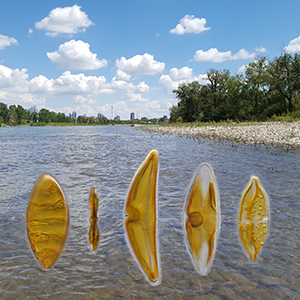Exploring diatom diversity through cultures - a case study from the Bow River, Canada

Accepted: 18 November 2022
HTML: 11
All claims expressed in this article are solely those of the authors and do not necessarily represent those of their affiliated organizations, or those of the publisher, the editors and the reviewers. Any product that may be evaluated in this article or claim that may be made by its manufacturer is not guaranteed or endorsed by the publisher.
Authors
Diatom cultures can help answer taxonomic, biogeographic and ecological questions on a local and global scale. Unialgal cultures are derived from a single cell and provide abundant material for morphological and molecular analyses. The link between the historic morphological species concept and the molecular data is becoming increasingly important with the use of eDNA metabarcoding. Additionally, cultures provide insights into the life cycle of diatoms and thereby complement taxonomy and species ecology. In this study, we present an approach to extract benthic diatoms from an environmental sample to generate unialgal cultures. We explored diatom diversity in preserved assemblages and by culturing as many different taxa as possible from benthic freshwater samples taken on the same day from the Bow River in Calgary, Canada. With both methods we found a total of 221 different benthic diatom taxa, of which 182 were identified in the preserved diatom assemblages. Interestingly, an additional 39 taxa only appeared in the cultures. In total 129 strains were cultivated representing 71 different taxa. This study includes pictures of living cells demonstrating the additional merits of unialgal cultures, as they provide information on plastid details, auxospores and endosymbionts. Both, the identification of the diatom assemblages and the generation and identification of strains provide the foundation for additional water quality assessment tools, taxonomic insights and molecular references libraries.
Edited by
Francesca Bona, Department of Life Sciences and Systems Biology, University of Turin, ItalySupporting Agencies
Verein der Freunde des Botanischen Gartens und Botanischen Museums Berlin Dahlem e.V. , Federal Ministry of Education and Research (German Barcode of Life 2 Diatoms, GBOL2)How to Cite

This work is licensed under a Creative Commons Attribution-NonCommercial 4.0 International License.
Similar Articles
- Oscar RAVERA, Anita FREDIANI, Nicoletta RICCARDI, Seasonal variations in population dynamics and biomass of two Unio pictorum mancus (Mollusca, Unionidae) populations from two lakes of different trophic state , Journal of Limnology: Vol. 66 No. 1 (2007)
- Roberto BERTOLANI, Roberto GUIDETTI, Ingemar K. JÖNSSON, Tiziana ALTIERO, Deborah BOSCHINI, Lorena REBECCHI, Experiences with dormancy in tardigrades , Journal of Limnology: Vol. 63 No. s1 (2004): Diapause In Aquatic Invertebrates
- Graziella MURA, Giovanni FANCELLO, Secondina DI GIUSEPPE, Adaptive strategies in populations of Chirocephalus diaphanus (Crustacea, Anostraca) from temporary waters in the Reatine Apennines (Central Italy) , Journal of Limnology: Vol. 62 No. 1 (2003)
- Andrea LAMI, Piero GUILIZZONI, Aldo MARCHETTO, High resolution analysis of fossil pigments, carbon, nitrogen and sulphur in the sediment of eight European Alpine lakes: the MOLAR project , Journal of Limnology: Vol. 59 No. s1 (2000): Climatic variability and ecosystem dynamics at remote mountain lakes
- Renato BAUDO, Biological monitoring of aquatic ecosystems in Italy , Journal of Limnology: Vol. 60 No. s1 (2001): Scientific and legal aspects of biological monitoring in freshwater
- Cristiana CALLIERI, John STOCKNER, Picocyanobacteria success in oligotrophic lakes: fact or fiction? , Journal of Limnology: Vol. 59 No. 1 (2000)
- Mattia M. Azzella, Italian Volcanic lakes: a diversity hotspot and refuge for European charophytes , Journal of Limnology: Vol. 73 No. 3 (2014)
- Bradley J. Austin, Violet Eagle, Michelle A. Evans-White, J. Thad Scott, Brian E. Haggard, Sediment phosphorus release sustains nuisance periphyton growth when nitrogen is not limiting , Journal of Limnology: Vol. 79 No. 3 (2020)
- Wei WANG, Ying LIU, Zhou YANG, Combined effects of nitrogen content in media and Ochromonas sp. grazing on colony formation of cultured Microcystis aeruginosa , Journal of Limnology: Vol. 69 No. 2 (2010)
- Gisela B. FRITZ, Martin PFANNKUCHEN, Andy REUNER, Ralph O. SCHILL, Franz BRÜMMER, Craspedacusta sowerbii, Lankester 1880 – population dispersal analysis using COI and ITS sequences , Journal of Limnology: Vol. 68 No. 1 (2009)
<< < 58 59 60 61 62 63 64 65 66 67 > >>
You may also start an advanced similarity search for this article.
-
Katherina Schimani, Nélida Abarca, Oliver Skibbe, Heba Mohamad, Regine Jahn, Wolf-Henning Kusber, Gabriela Laura Campana, Jonas ZimmermannMetabarcoding and Metagenomics : 2023

 https://doi.org/10.4081/jlimnol.2022.2095
https://doi.org/10.4081/jlimnol.2022.2095





